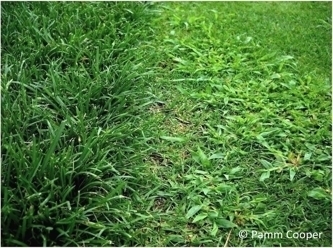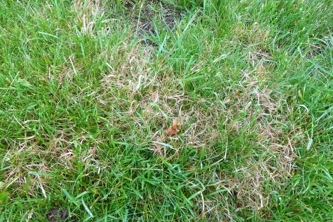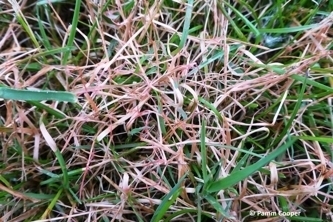Many people are interested in reducing their use of water, synthetic fertilizers or pesticides on their lawns. There are concerns of the potentially harmful effects to humans, pets, wildlife, beneficial insects, and the possible harm to groundwater from pesticides and the leaching of synthetic fertilizers. There are naturally occurring resources and mechanical practices that may be used in place of synthetic fertilizers and chemical pesticides that can provide an acceptable level of lawn maintenance with a minimum impact on the environment. Organic lawn care is about the process of growing and managing a lawn, not about the products used or not used on the lawn.
Knowledge of proper lawn management practices, understanding different turf species and their growing requirements, pests of turfgrass and watering and fertilization requirements of turf species is essential. Every lawn is not identical in available light or soil conditions. Turf species that do well in one area of the property may not do so well in another area if available light, soil type and other factors are quite different. Soils differ in their ability to hold moisture, and lighter soils may not be suitable for certain turf species. Knowledge of insect pests and fungal diseases, and how they may be influenced by weather and management practices, is essential.
The key to successful organic lawn care management is the realization that one cannot simply substitute natural organic products for synthetic ones. It is essential to learn about the cultural needs of turfgrasses and improve existing site conditions to favor the growth of desired grass species. Regular monitoring for pest problems, proper identification of any pest, and knowledge of the pest’s lifecycle, whether a weed, insect or disease, will help determine how to effectively control it. Tolerance of a few weeds, insects, and some imperfections may be part of an organic lawn care program. Limiting factors such as poor soil quality, excessive shade or sun conditions or choosing not to fertilize or water will all affect turf quality.
Cost is another factor to consider when switching to an organic lawn care management plan. In general, it is more expensive than non-organic alternatives and requires a greater time commitment, especially in scouting for weeds, insects and disease issues.
Turf Species Selection
Selecting the proper turf grass species for particular lawn conditions and desired lawn quality is important. Not all situations are conducive to growing a picture-perfect lawn. Three species of cool season grasses grow well in Connecticut; Kentucky bluegrass, fescues and perennial rye grasses.
Kentucky bluegrass and ryegrass have higher water and nutrient requirements than fescues. They also need more hours of direct sun than fescues. If you do not intend to use supplemental irrigation or fertilizers, then fine-leaved fescues would be a better choice than Bluegrass or ryegrass. Fine-leaved fescues are drought tolerant once established and they require less nitrogen fertilizer than Kentucky bluegrasses and perennial ryegrasses. Turf-type tall fescues are also suitable for low water situations, if the soil structure allows for deep root establishment. All fescues are shade tolerant, but do require a minimum of four hours of direct sun each day.
No turf species will thrive if planted in areas that receive less than four hours of direct sun each day. Choose a shade tolerant ground cover instead. For more information on turf grass selection, see the Guidelines for Selecting An Appropriate Grass For Your Lawn fact sheet at the UConn Home & Garden Education Center.
Soil Preparation and Testing
The condition and properties of the soil determine to a great extent how well turfgrasses will perform. For optimum growth, lawn do best with 4 to 8 inches of topsoil with a pH between 6 and 7, moderate amounts of organic matter, good drainage, and adequate levels of nutrients. Sandy loams are ideal soils for lawns, and for most areas of Connecticut this soil textural class predominates.
A soil test will determine the pH of the soil and the levels of available plant nutrients. This information is useful when deciding the best turfgrass species to plant on a particular site. Soil testing helps rule out any nutritional problems an established lawn might be experiencing and when recommendations are followed, helps new lawns get off to a good start. If the soil pH needs to be raised, the amount of ground limestone to apply will be listed. The pH of the soil affects the availability of all plant nutrients, whether fertilizers are used or not.
Soil test results typically come with synthetic fertilizer recommendations. Request natural/organic fertilizer recommendations when submitting soil sample. Synthetic products tend to have a more uniform nutrient ratio and are readily available. The variability and the availability (or sometimes unavailability) of natural/organic fertilizers makes it difficult for soil testing labs to recommend specific products. At the UConn Soil Nutrient Analysis Lab, a table is provided for the amount of natural organic lawn fertilizer to apply based on the nitrogen content of the natural organic fertilizer of the client’s choosing. Fertilizers containing phosphorus suitable for established lawns are regulated in Connecticut. The use of phosphorus is allowed whenever sodding or seeding a new lawn area or when over-seeding an existing lawn. See the Your Lawn & the New Phosphorus Law fact sheet .
Soil tests can also measure the percentage of organic matter in the soil, which is important as soils with adequate amounts of organic matter have an increased ability to retain moisture and nutrients. This may be a separate test so check with the laboratory before sending samples. Visit the UConn Soil Nutrient Analysis Laboratory site for additional information on soil testing.
Natural Organic Fertilizers
Switching from synthetic to organic fertilizers may not provide immediate results. Chemical or synthetic fertilizers typically have a greater portion of their nutrients in water soluble forms which are immediately available to the plants. Organic lawn fertilizers are composed of ingredients like alfalfa meal, nitrate of soda, corn gluten, feather meal, and cottonseed meal. Natural organic products which contain manures, animal or plant-based meals, and rock dusts, may have some readily soluble forms of nutrients to offer plants, but they mainly rely on microbial action and weathering to release the nutrients. This takes time and is dependent upon environmental conditions.
Soil microorganisms decompose or break down natural organic fertilizers whether applied as single ingredients like bloodmeal or blended fertilizer products. As they decompose, this organic material it is transformed and made soluble through a general, natural process called mineralization. Plants take up nutrients in soluble forms dissolved in the water taken up by their root systems. The organisms responsible for this process are more active in warm, moist soils than when cold temperatures or drought conditions prevail. Beneficial microbial populations can become depressed or imbalanced when synthetic fertilizers have been used for periods of time. A healthy and diverse soil food web serves as the foundation for plant life. Increasing the level of organic matter in the soil and eliminating the use of synthetic fertilizers will encourage bacteria and fungi and other soil microbes to colonize the soil. Some natural organic fertilizers now include the actual live bacteria that are needed to break down the nutrients in their products.
All fertilizers, synthetic or natural/organic, come with a guaranteed analysis. These are the three numbers on the fertilizer package (e.g. 5-3-2) and represent the percentage on a dry weight basis of total nitrogen, available phosphate and water soluble potassium, commonly abbreviated to N-P-K ratio. Since natural organic fertilizers are derived from plants, animals and minerals, they typically contain lower percentages of nutrients than synthetic products. A larger amount of natural fertilizer might be needed to satisfy plant needs.
When fertilizing the lawn one pound of nitrogen for every 1000 square feet is the goal. Fertilizer can be applied after April 15th and before October 15th. Usually one application in the spring and one in the fall is sufficient. Grass clippings should be left on the lawn as they slowly increase the soil organic matter and supply one-third of the lawn’s nitrogen need. To convert organic fertilizer application amounts please see Fertilizer Conversions and Garden Measurements.
Topdressing
Established lawns can be top dressed with mature compost to help thatch decompose and will add organic matter and nutrients to the soil. If combined with aerification in the spring or fall, topdressing with compost can help avoid a buildup of thatch on the soil surface. Core aerify and then apply a quarter inch or so of compost, and rake into the holes.
Another topdressing material that can be used is soil. Choose a soil that is of similar physical characteristics to the existing one to avoid layering. Apply lightly to the turf in spring and fall and rake it off the grass blades.

Aerification
Aerifying every few years helps alleviate surface compaction of the soil which allows water, air, and nutrients to enter it. Grass will perk up within hours after core aerifying. Seed can also be put down afterward, or one could aerify first and then slice seed if the lawn is thinned out. If lime needs to be added, an ideal time to apply it is when aerification is done and holes are still open.
Weed Control
If crabgrass is a problem, keep the turf cut to a height of 3 inches and overseed wherever the lawn begins to thin out. The higher cut and repeated overseeding will keep the desirable grasses dense and may prevent crabgrass seeds from germinating as they require exposure to light. Crabgrass can prevail along road edges either from salt runoff or higher soil temperatures during the summer. Try overseeding with the more salt and heat tolerant fine-leaved fescues in these areas.

Corn gluten (9-0-0) has been tried by many homeowners as a natural weed control for crabgrass and other annual weeds, as well as serving as a source of nitrogen. A conundrum occurs when using corn gluten as directed for weed control; twice as much nitrogen (about 2 lbs./1000 sq. ft.) would be applied than is typically recommended (1 lb./1000 sq. ft. [M1]). Use of corn gluten can be effective in some instances as a weed control, but it can backfire during the germination of weed seeds if rainfall occurs. A dry period of at least a week is required when weed seeds will be germinating or the corn gluten will not work. Corn gluten prevents the initial root from forming on a new seedling. If irrigation or rainfall occurs during that time, the seedling will recover and form its new roots, and weed control can be spotty. If weeds become established, the corn gluten will provide 2 lbs. of nitrogen released over the next several weeks to open the door for excellent weed growth. Corn gluten stops the germination of all seeds, including desirable turfgrasses.
Annual weeds are be best controlled by keeping the lawn grass dense and tall. This practice helps to block sunlight from reaching new weed seedlings giving them solid competition from taller turfgrasses. If annual weeds are seen, pull them up before they produce seed and put some grass seed in that open spot. Avoid fertilizing in the summer months, as this promotes summer annual weeds and stresses cool season lawn grasses that are just trying to survive the heat. Perennial weeds are the hardest to control, but they can be reduced over time by mechanically removing them or using organic spot treatments like acetic acid-based products.

Insect Control
Be aware of what is going on in your lawn. Scout periodically for weeds, insects, diseases or other damage. Learn to recognize common insects found on lawns. Some insects are very beneficial to lawns such as ground beetles. Even some ant species will eat grubs and other lawn insects. There are also insects that feed on weeds but usually not enough to eliminate them. Always identify the pest causing the problems before deciding on a control measure. Some control techniques may be friendlier to the environment and towards biodiversity than others.
Grubs and other insect pests can often be controlled at an acceptable level by cultural and biological means. If surface feeding insects such as chinch bugs, sod webworms or billbugs have been a chronic problem, endophyte-enhanced turf grasses may be used. These grasses have a naturally-occurring fungus that lives within the plant (except in the roots) which is toxic to insects feeding on leaves and stems. Endophytic grasses include some cultivars of fine fescue, perennial ryegrass, and turf-type tall fescue. Because grubs feed on the grass roots, endophyte- enhanced grasses will not help control grubs.
Parasitic nematodes can also be used for lawn insect control with Heterohabditis and Steinernema species showing promise for grub control. Some grub species are not as susceptible to commercially available parasitic nematodes, such as the European chafer. It is recommended that the grub species be identified before purchasing nematodes. Grubs can be identified at the UConn Home & Garden Education Center. Milky spore disease, (Paenibacillus popilliae) formerly known as Bacillus popilliae, is a somewhat effective bacterial control for Japanese beetle grubs. Milky spore disease is a bacterium not effective against any other beetle grubs. Irrigating grasses under attack from grubs can give the grass an opportunity to regrow roots from the crown.
Turfgrass Diseases
Some turf diseases can be reduced in intensity by proper fertilization rates and timing. Avoid fertilizing after mid- October to ensure grasses will not be lush going into cold weather. Snow molds can be a significant problem if snow cover occurs after late season nitrogen fertilization applications followed by snow cover over unfrozen ground.
Red thread is a disease common on under-fertilized lawns if there is an extended cool and moist spring. Even a low maintenance lawn is subject to this disease which affects the leaves, not the crown or roots. Fertilizing with a reduced rate of a quick release nitrogen fertilizer may help grass recover faster from red thread.
Pythium and brown patch are two diseases that can quickly destroy certain turfgrasses if conditions are right. Do not fertilize cool season grasses during the heat of summer and avoid overwatering as these two practices, when combined, can increase the chances for the development of these two diseases, especially during the heat of summer.
There are some cultivars of turf grasses are sold that are resistant to the development of brown patch and red thread. Over seed with these in areas where brown patch or red thread are chronic problems. Keep in mind that proper fertilization and judicious irrigation will go a long way in reducing the incidences of many lawn diseases.

Red thread disease in lawn and up close.

Summary
Proper maintenance practices combined with the selection of the most suitable turf grass for soil and environmental conditions can greatly improve lawn quality. A few weeds may not be objectionable to many people. Avoiding the use of synthetic fertilizers and pesticides, especially over many seasons, increases the populations of beneficial insects and other creatures in the soil. Landscaping with plants native to your area may also do the same. A property does not necessarily have to have the majority of its area covered with lawn. Nature has a way of revealing the best-case scenario for each individual landscape or lawn.
Despite good cultural practices, pests and diseases at times may appear. Chemical control should be used only after all other methods have failed.
For pesticide information or other questions please call toll free: 877-486-6271.
Photo © 2018 Pamm Cooper
Issued in furtherance of Cooperative Extension work, Acts of May 8 and June 30, 1914, in cooperation with the U.S. Department of Agriculture, the Dean of the College, Cooperative Extension System, University of Connecticut, Storrs. The Connecticut Cooperative Extension System is an equal opportunity employer and program provider. To file a complaint of discrimination, write USDA, Director, Office of Civil Rights, Room 326-W, Whitten Building, Stop Code 9410, 1400 Independence Avenue, SW, Washington, DC 20250-9410 or call (202) 720-5964.